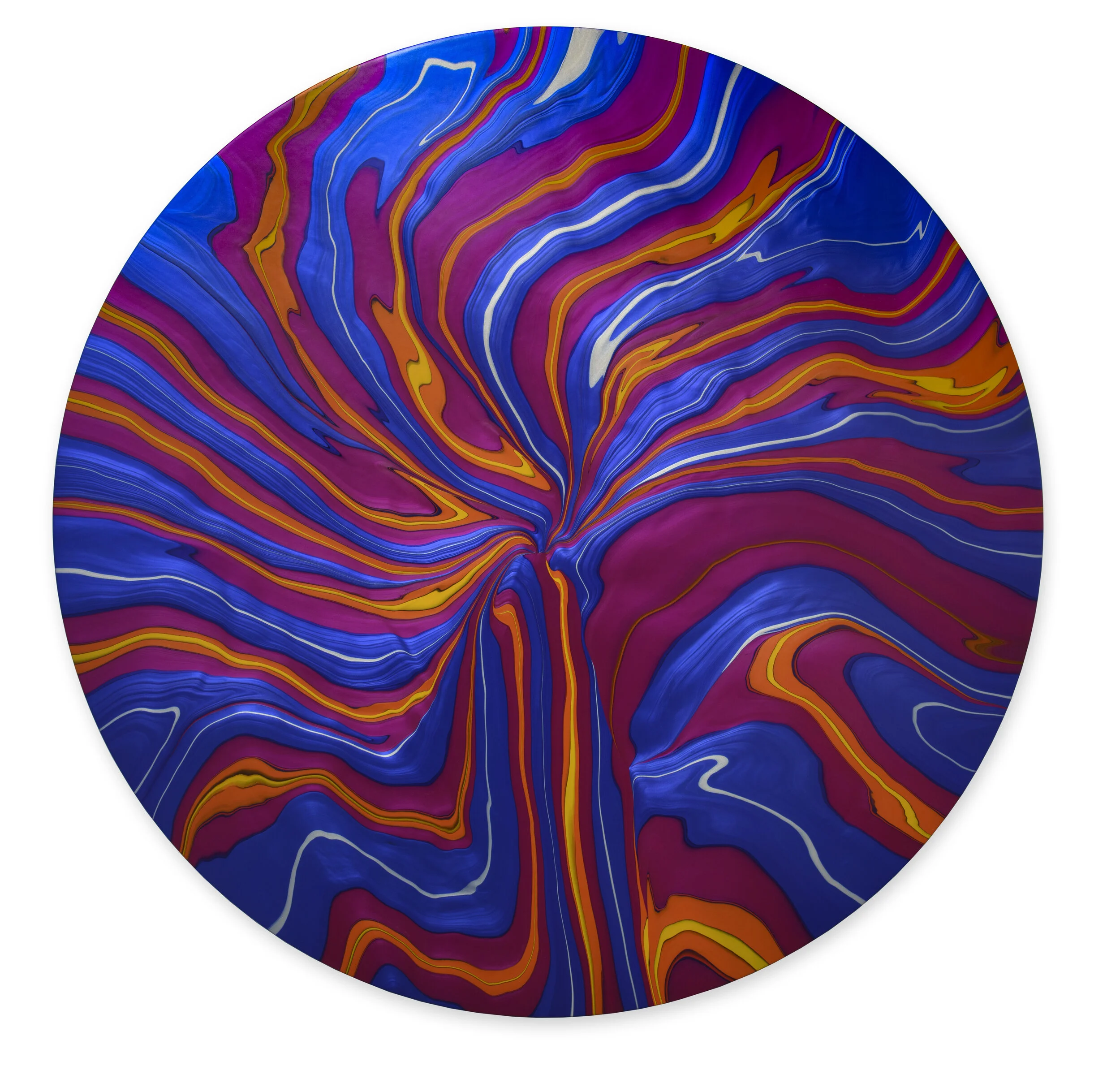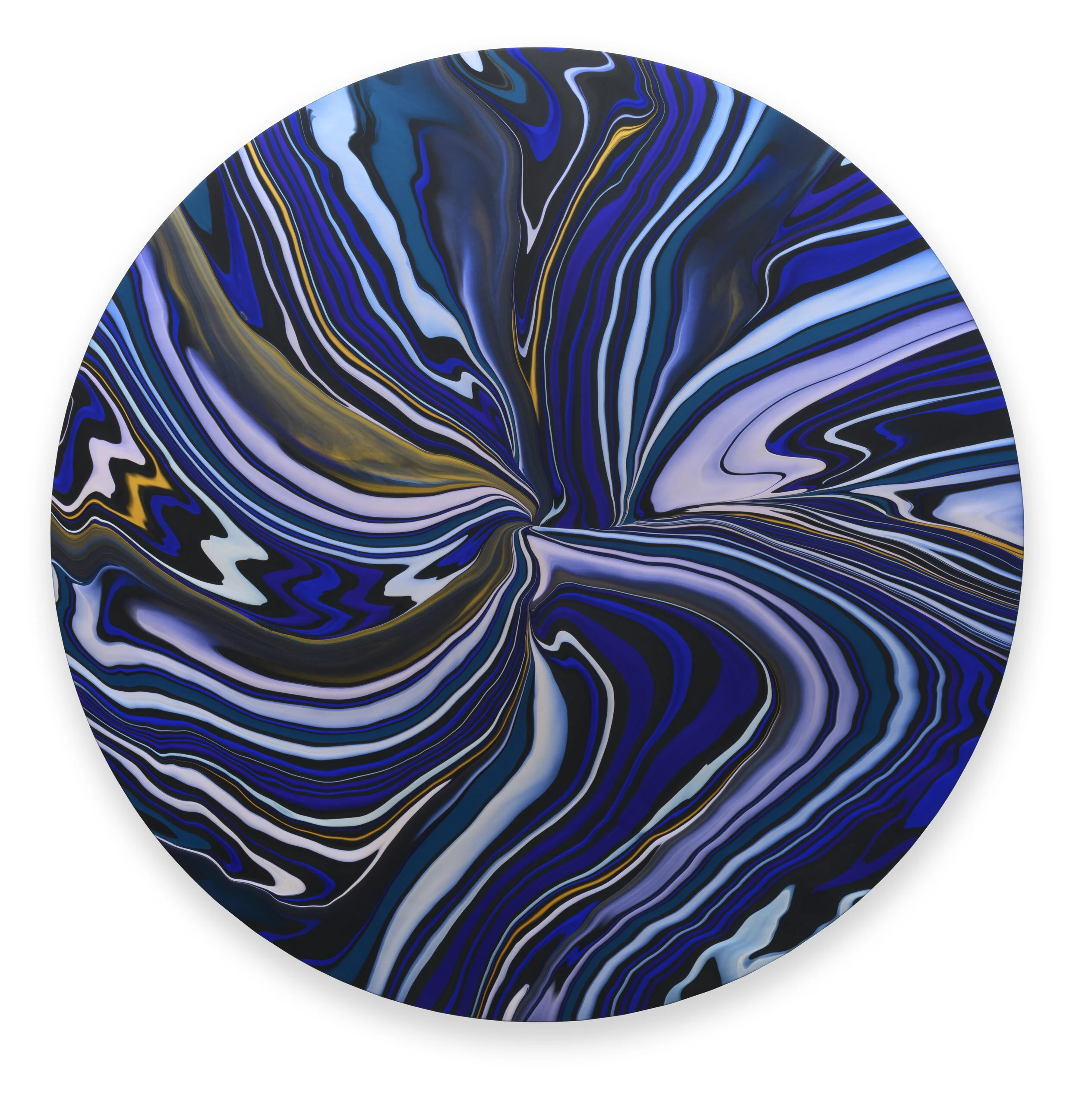ANDY MOSES

“I have always been interested in trying to capture that feeling of being alive.”
Interview by Amanda Quinn Olivar, Editor
Born in Los Angeles in 1962, Andy Moses attended the legendary CalArts, studying with John Baldessari, Michael Asher, and Barbara Kruger. In 1982, Moses moved to New York where he worked as a studio assistant to Pat Steir. He quickly became part of the nascent ‘80s art scene and became one of the youngest artists to exhibit with Annina Nosei gallery after Jean-Michael Basquiat. During that time he developed close ties with then-emerging artists like Jeff Koons, Marilyn Minter, Rudolf Stingel, and Christopher Wool. Moses returned to California in 2000 and really began to refine his explorations into the physical properties of paint that have brought him to the attention of museums and major collectors alike.
His work is included in the permanent collections of Los Angeles County Museum of Art, Orange County Museum of Art, Laguna Art Museum, and the Frederick R. Weisman Art Foundation. He currently lives and works in Venice, CA.
AMANDA QUINN OLIVAR: I remember going to one of your earliest LA exhibits, with the rock paintings. When were you first inspired by nature? Has your art continued to revolve around it?
ANDY MOSES: Nature continues to be my first and main source for inspiration in my painting. I have always been interested in trying to capture that feeling of being alive. When you immerse yourself in nature you feel alive. The rock paintings you mention are from a show I had in 1988 at Asher Faure Gallery. Brian Butler, who now owns gallery 1301PE, was actually their director at that time, at Betty and Patty’s space on Almont Street. Your mother and father, Joan and Jack, actually bought two rock paintings before that exhibition in either 1986 or 1987.
Veil of Time, 1986, acrylic on alkyd on canvas, 60” x 90”, courtesy of the artist. Photo by Alan Shaffer
AQO: Have other themes resonated throughout your career? Talk about the importance of form, energy and structure...
AM: Those are all great questions. Form, energy, and structure are what my work is very much about. I feel that form is essential to all painting. You create form in some sense within the picture field, but I’m also interested in the overall form or structure of what a painting of mine is and how that relates to form in general. In this recent exhibition at William Turner Gallery, each painting is one of three geometric forms: circular (which I refer to as tondos), hexagonal, or concave rectangles. In the tondos and hexagons, the form is emerging out of the center and the exterior form is defined by that emergence from the center. The panoramas are different. The overall composition is a little more conventional in that it is describing a pictorial landscape, or as I like to think of them, earthscapes. The earthscape being a little less like traditional landscape forms and a little more like an imagined form of some part of the earth. I am interested in this dance between pure abstraction and the suggestion of forms from the natural world. These concave curved rectangles come out of gestural abstraction but they do become pictorial, but of something that is in motion.
Geodesy 1508, 2020, acrylic on canvas over circular wood panel. Photo by Alan Shaffer
Installation photographs courtesy William Turner Gallery. Photo by Alan Shaffer
AQO: Does your technique allow you to develop your vision? If so, how?
AM: My technique and my vision are now essentially one and the same. During the eighties, and part of the nineties, my work process involved techniques of mixing oil and water-based paints. It was something that you weren’t supposed to do, and I loved the sense of experimentation and the unexpected images that resulted. The paintings from that time looked like galactic explosions, microscopic phenomena, or stone surfaces. After moving back to Los Angeles, beginning in the early 2000s, I began a series of paintings that looked more like liquid motion, involving all kinds of phenomena. I’m constantly looking to nature to suggest what will be in these paintings. It’s a magical process that’s hard to describe, but it’s almost like a transmutation of energy that occurs between seeing and creating.
AQO: How has 2020 affected your practice?
AM: This year has been interesting. I am happy that around the time when lockdown began in March, I was working on the show that opened this December at William Turner Gallery. This is my first solo exhibition in Los Angeles since my 30-year survey in 2017. I am excited about this show because it’s the most ambitious body of work to date, and the first time I will be exhibiting such a broad range of imagery in one exhibition. I also feel like I am at my peak so far in terms of expression, and these new paintings sing loudly.
AQO: What childhood experience do you think helped shape the way you view the world?
AM: I merged myself into the ocean as a teenager. It became my true field of inquiry. I was awed by the way patterns could be created in moving water and by the fluid and sinewy nature of water and the ocean. It’s this powerful field that magnetizes all that’s around it. These images and the powerful forces that form them have been a very large part of my interest and inspiration since that time.
Geodesy 1505, 2019, acrylic on canvas over circular wood panel. Photo by Alan Shaffer
AQO: You were told by your dad, artist Ed Moses, that you could do anything... except art. What were you doing before you took this path to painting? What led you to change direction?
AM: Yes, my brother and myself were totally discouraged from making art. My first true passion in life was the ocean and I felt like it would be a constant part of me for the rest of my life. I was never quite sure if I would surf and build boards or become interested in oceanography or marine biology. I was interested in math and science for a while but for some reason my teachers beat the joy out of me in those areas. Later on, I was interested in writing and possibly directing. There were so many people needed to put together a film, so for me that was discouraging. At CalArts, I actually began studying film but it didn't take long for me to switch to painting. As soon as I started painting I knew that was it. I was hooked for life. I could capture what I needed to and it was my new energy source.
AQO: Please talk about Recent Works, your new exhibit on view at William Turner Gallery.
AM: As I mentioned earlier, I am currently working with three distinct shapes. In the hexagons and tondos, I am trying to create these discreet, beautiful images, these microcosms of the universe, that nonetheless sing loudly about the vastness of the whole. With the concave panoramic paintings - the rectangles - I’m looking to instill a slightly different experience. I want them to take the viewer on a longer journey of looking - out deep into space and back. I want you to absorb that and everything in between.
AQO: What do you hope to communicate? Are there specific reactions you want to stir up/conjure in your audiences?
AM: I want the paintings to be beautiful. I want them to stop you in your tracks, so you can immerse yourself in a moment of beauty.
Installation photographs courtesy William Turner Gallery. Photo by Alan Shaffer
Installation photographs courtesy William Turner Gallery. Photo by Alan Shaffer
AQO: Did you listen to music while making this series? Describe the atmosphere in your studio when you're working.
AM: When I make a painting it happens within hours and everything has to work out perfectly. I have to be relaxed and also totally in the zone. I do listen to music but never too loudly. I almost feel hypnotized when I am painting because it's an extreme moment of concentration. There is so much time spent making colors and then making conglomerate jars and buckets of paint. It's very precise and it's very arduous. Fortunately, I have assistants that help me with a lot of that process.
AQO: What would surprise us about you, Andy?
AM: The reaction I most often get when people visit the studio is how methodical I am in my approach. I often feel like an alchemist, recording precise formulas of paint combinations - which most people don’t expect from an “abstract” painter. I literally have hundreds of buckets of paints with the exact proportions of each color that went into that particular combination.
AQO: What is your favorite art accident?
AM: I love when something totally unexpected occurs, which creates an “Ah Ha” moment. One such moment that comes to mind is what led to the curved and shaped canvases. I was working on a painting on a regular stretcher bar, which had warped. I had set it against the wall, left the studio, and when I returned noticed how the curve caught the light and activated the surface in a way that was more dramatic than when it was simply flat. It created an engagement that felt very interactive, which I loved, and which led to an entirely new direction in my work. For accidents to become creatively potent, you really have to be present and ready for the unexpected, and open and attentive to the moment. It’s the thing that draws me back to the studio each and every day - you never know what’s waiting to be discovered!
Installation photographs courtesy William Turner Gallery. Photo by Alan Shaffer
Andy Moses: Recent Works
William Turner Gallery
December 5 — February 10, 2020
Feature portrait of Andy Moses by Alan Shaffer






